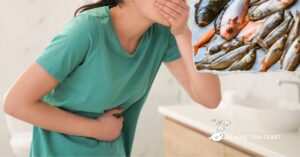Do you want to know how much fish food to add for fishless cycling? For fishless cycles, start with a pinch of fish food comparable to what you would feed a small fish daily and adjust according to aquarium size and water conditions.
Fishless cycling is building healthy bacteria within your aquarium environment to balance the nitrogen cycle flow before you add fish.
As you read on, you will learn the role of fish food in fishless cycling. I will also read details about how much fish food you can add to your aquarium.
Now, let’s get started.
Table of Contents
How Much Fish Food To Add For Fishless Cycling
Now, let’s delve into the role food plays during fishless cycling. Fish food serves as the ammonia source. When it decomposes, it releases essential ammonia into the water.
Determining how much food your tank needs to support fish is vital. The amount of fish food you put depends on your tank size.
Start with a pinch of fish food like you would feed a 20-gallon aquarium tiny fish every day.
Monitor ammonia and nitrite levels during cycling with test kits. Ammonia and nitrite rise during cycling but fall when beneficial bacteria develop.
Partial water changes may be needed to dilute pollutants at harmful levels.
Water temperature and starting ammonia levels affect fishless cycling, which takes 2–6 weeks. The cycle ends when ammonia and nitrite levels reach zero and beneficial bacteria have established a stable colony.
Patience is key during fishless cycling. Avoid adding fish too early, which can stress and injure aquatic creatures. Keep the aquarium aerated and well-maintained throughout the cycling process.
Step-by-step Process: fishless cycling
I suggest the following fishless cycling method as it is easy to use and highly efficient.
Step 1: Install and operate the filtering system as usual
Before beginning a fishless cycle regime, set up the temperature and filtration system of the fish tank exactly as if there were fish present.
It would help if you also operated the circulating pump continuously.
Step 2: Fill the tank with a tiny quantity of pure ammonia each day.
Over a few days, add pure ammonia to the aquarium until the total ammonia (NH3 and NH4) reaches no more than 1–4 mg/liter.
Optional ammonia levels. You must know how much ammonia to add to reach these levels.
Add 0.5 milliliters of 10% ammonia solution to 100 liters of tank water to simulate a fish aquarium.
Ammonia levels rise from 0.5 to 2.5 mg/liter after 5 days without nitrification.
Total tank volume = length x width x depth in cm / 1000.
A 120 cm by 60 cm by 50 cm container holds 360 liters and needs 1.8 milliliters of 10% ammonia daily.
The volume of a tank is its length, which is times its breadth and depth in centimeters divided by 1000.
Thus, a 120 cm by 60 cm by 50 cm container holds 360 liters and requires 1.8 milliliters of 10% ammonia solution daily.
Not too exact, but don’t add too much ammonia since this will slow down the filter bacteria’s rate of development.
Step 3: Pay special attention to the amounts of nitrite and ammonia.
Utilize a suitable ammonia test kit to ascertain the present amount after three days. Proceed to Step 4 if the level is getting close to zero because you need to add additional ammonia.
Retest after a few more days if there has yet to be much of a change in the tank.
Step 4: Keep up the daily ammonia dosage and keep an eye on the water’s quality
Every day, add another dosage of ammonia, then retest. At this point, the fishless cycle should begin as the nitrite levels climb.
Use a nitrite test kit to verify if this is indeed occurring. After another two days, leave the aquarium running and go to Step 5.
Step 5: To promote heterotrophic bacteria, add a tiny amount of fish food each day.
Do repeat tests for ammonia and nitrite, ideally every day. The cycle process should be well underway by now.
A drop in nitrite and ammonia will indicate this. You might now begin using a nitrate test kit to get more proof that nitrification is indeed occurring.
Now that the NOB is changing the nitrite into nitrate, this metric ought to be rising.
What Is Fish-Less Cycling
The term “fishless cycling” refers to the process of developing the nitrogen cycle in a new aquarium without the use of fish.
It entails adding a supply of ammonia to the aquarium water to resemble fish feces.
The idea is to cultivate a colony of helpful bacteria that can degrade ammonia into less damaging substances, producing a healthy habitat for your fish.
In the process of fishless cycling, it is common to add a source of ammonia to the aquarium water, such as purified ammonia (in the form of ammonium chloride) or fish food.
Phantom feeding is the practice of providing fish food without having any fish in the tank. When bacteria in the aquarium break down ammonia, they generate nitrite (NO2), which is hazardous to fish even at low levels.
Over time, a second type of bacterium known as nitrite-oxidizing bacteria would emerge and convert the nitrite (NO2) to nitrate (NO3), which is quite innocuous to fish at low doses.
Nitrate levels of 20 ppm or less are considered safe in most aquariums.
What Are The Steps To Add Fish Food For Fishless Cycling
The actions to take are as follows:
Assuming that the tank is completely supplied, add food as often as possible. We refer to this as “ghostfeeding.”
Thus, add three pellets a day to your tank if you want to feed your betta, say, three pellets every day in a ten-gallon aquarium.
If ammonia and nitrite levels get too high, replace the water. See this page for further information about when to perform a water change.
You may call your tank “cycled” if you can ghost feed without changing the water for around 10 days in a row, and the levels of ammonia and nitrite don’t rise during that period.
To reduce the amount of ammonia/nitrite created, you can gradually increase the amount you feed instead of changing the water as often.
As was said before, you can get to the point where you can “ghost feed” on your own. However, this will lengthen the process.
Why Add The Fishless Cycling Method For Fish Food
Historically, cycling a new fish tank involved introducing a small number of hardy fish, such as danios or feeder guppies.
The ammonia produced by these fish was essential to the survival of the bacteria.
However, these fish are subjected to dangerously high concentrations of ammonia and nitrite until the filter is fully developed. Even hardy fish can become ill or die from the stress this generates.
How Does A Fishless Cycle Work For Fish Food
A mix of beneficial microorganisms and an ammonia supply are used in fishless cycling. The bacteria will take up the ammonia when it is supplied and break it down into nitrate.
The aquarium eventually reaches the stage when it has an adequate amount of germs to accommodate new animals.
Using resilient fish to cycle an aquarium was a common approach back when aquariums were first introduced, which is when I got started.
Most of the time, the aquarium owner’s larger show fish would devour these unfortunate sacrifice fish, or they would not survive at all.
The fish that people would employ for cycles in saltwater aquariums are damselfish.
The resilient small fish would typically make it through a cycle, but because they are highly territorial and should be added last, they would become nightmares in a communal tank.
What Are The Benefits Of Fishless Cycling
In contrast to the conventional way, fishless cycling enables you to develop the system without putting fish in danger by subjecting them to the toxic effects of dirty water.
It implies that you won’t have to pick resilient fish that you wouldn’t necessarily want to maintain in the tank otherwise.
In addition, if it is done properly, you can attain a higher stocking density more quickly and safely than the traditional way would.
Final Thought
By now, you have learned from this article how much fish food to add for fishless cycling.
Fishless cycling is fundamental in creating a healthy and thriving aquarium for your fish.
You have also seen that using fish food as an ammonia source and following proper cycling techniques can ensure a healthy environment for your aquatic animals.
Don’t forget that water plays a key role in the successful transition of your fish into their new home.
That is why you must always closely monitor your water parameters and exercise patience throughout the process.
I hope your nitrogen cycle goes well!




